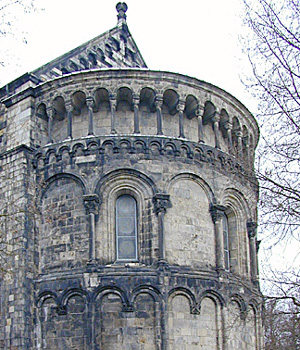| Lund Domkirke

| | Knud den Hellige skænkede i 1085 jord med henblik på opførelse af en domkirke i Lund.
I 1104 anerkendes Norden første gang som en selvstændig kirkeprovins og omkring samme tidspunkt påbegyndes byggeriet af domkirken som står færdigbygget i 1145. |
I 1085 skænkede kong Knud den Hellige en stor gave til bispesædet i Lund. Gaven bestod i en række ejendomme på begge sider af Øresund. Desuden skulle Lunds Domkirke nu have skattepenge fra byen Lund, men også fra byerne Lomma og Helsingborg. Baggrunden var, at de danske byer betalte grundskat til kongen, eftersom han stod som ejer af de grunde, byerne blev opført på. Skatten blev kaldt for midsommerskatten. Det var dele af den skat, som Knud den Hellige skænkede til domkirken i Lund. Da midsommerskatten kun blev betalt af etablerede byer, står det klart, at Lund, Lomma og Helsingborg blev grundlagt før den 21. maj 1085, og altså hermed var Skånes første byer.

Lund i 1500-tallet | 
Lund Domkirke | 
S:t Laurentius | 
Astronomisk ur | 
Evangelieskrift |
Ærkebispesædet
I 1089 fik Lund en ny ærkebiskop, Asser, medlem af en af de fremtrædende stormandsslægter, Trued-slægten, og det var i hans tid, at Lund blev ærkebispesæde for hele Norden. Dette skete i 1103, og herefter påbegyndtes opførelsen af Lunds nye domkirke. Den blev bygget på den samme plads som Knud den Helliges domkirke, men skulle efterhånden få imponerende dimensioner, som passede bedre til et ærkebispesæde.
Kirken stod færdig i 1145, hvor den blev indviet af ærkebiskop Eskild, brorsøn til Asser og indsat som ærkebiskop i 1137. Lund var ærkestift for hele Norden frem til 1152, da Norge fik sin egen organisation og Sverige blev løsrevet fra Lunds ærkestift i 1164. Herefter var Lunds Domkirke udelukkende dansk domkirke og ærkebispesæde.
Bygmesteren
Som bygmester for det imponerende prestigebyggeri indkaldtes den lombardiske arkitekt, Donatus. Kirkerummet betragtes af mange, som noget af det ypperligste i den romanske kirkekunst.Omvendt er en yderst hårdhændet ydre restaurering i 1800 tallet beklaget fra mange sider.Karakteristisk for den lombardisk inspirerede kunst er en udstrakt brug af dekorative elementer på portaler figurer.

Sydindgangen | 
Sydportalen (detalje) | 
Lund | 
Krypten | 
Trolden Finn |
|